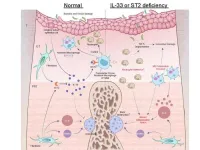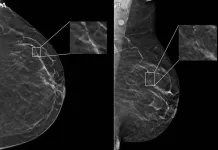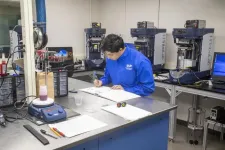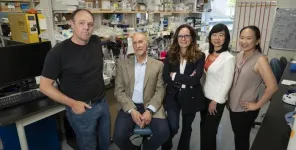Tracking down toxic metals from tobacco smoke
Scientists reveal surprising new clues behind the lingering health effects of secondhand and thirdhand tobacco smoke
2024-05-21
(Press-News.org) Cigarette smoke has been studied for years, revealing a multitude of contaminants, including toxic metals. But exactly which of those metals can be traced to secondhand or thirdhand smoke? Solving this problem has been a challenge for the research community because many of the metals found in tobacco smoke could also come from industrial or naturally occurring pollutants contaminating indoor and outdoor air.
Now, a recent study by scientists at Lawrence Berkeley National Laboratory (Berkeley Lab) has identified 28 trace metals in tobacco smoke. The findings reported in the journal Environmental Science & Technology Letters point to new evidence behind the long-term health effects of secondhand and thirdhand tobacco smoke. Secondhand smoke is the smoke released by a burning cigarette. Thirdhand smoke is the noxious tobacco residue that settles on indoor surfaces long after a cigarette has been put out.
“It is important to quantify the trace metals from secondhand and thirdhand smoke because some trace metals are present in other indoor and outdoor pollution sources,” said Hugo Destaillats, the principal investigator of the study, and a senior scientist in the Indoor Environment Group of Berkeley Lab’s Energy Technologies Area. “For well over a decade, our group has studied toxic organic contaminants emitted during smoking. We are now also interested in completing the picture of smoke’s persistent legacy by assessing how trace metals may contribute to tobacco’s health burden.”
During experiments in a room-size environmental chamber at Berkeley Lab, a team from the Indoor Environment Group collected samples of aerosol particles over a period of 43 hours after smoldering six cigarettes. To characterize secondhand smoke, they used Teflon-coated filters to capture freshly emitted aerosol samples immediately after smoldering. Then, they took additional samples over longer time periods to characterize thirdhand smoke.
Co-author Wenming Dong, a research scientist in Berkeley Lab’s Earth and Environmental Sciences Area (EESA), used an advanced triple quadrupole inductively coupled plasma mass spectrometry (QQQ ICP-MS) system in the EESA Aqueous Geochemistry lab to detect significant levels of 28 trace metals in secondhand and thirdhand smoke. Among these were several toxic metals such as cadmium, arsenic, chromium, beryllium, and manganese.
To have a better understanding of how trace metals can contribute to the chemical composition of secondhand and thirdhand smoke, the researchers then used the experimental results from the environmental chamber study to predict the concentration of trace metal contaminants in a smoker’s home, and in nonresidential scenarios such as smoking bars, under different air exchange rates. In almost all of the modeled scenarios, they found that the predicted indoor air concentration for cadmium, arsenic, and chromium exceeded the state of California’s cancer risk guidelines. They also found that some of these metals exceeded the state’s non-cancer reference levels for chronic exposure.
The Berkeley Lab researchers say that this study is a first step in understanding how tobacco smoke may contribute to our overall exposure to trace metals in the indoor environment, and that more work is needed to advance the remediation of secondhand and thirdhand smoke pollution.
“In smoking environments, these trace metals are found in indoor air and also on surfaces and in dust particles, and people can be exposed to them through pathways such as dermal uptake and ingestion,” said Xiaochen Tang, a researcher in the Energy Analysis and Environmental Impacts Division of Berkeley Lab’s Energy Technologies Area, and first author of the study. “We focused our analysis on the inhalation of airborne metal contaminants, so our results represent only part of the total exposure burden. Given the persistence of trace metals in the environment, it would be important to better understand the efficacy of ventilation, cleaning, and vacuuming as removal mechanisms for these contaminants.”
This work was supported by the University of California’s Tobacco Related Disease Research Program.
###
Lawrence Berkeley National Laboratory (Berkeley Lab) is committed to delivering solutions for humankind through research in clean energy, a healthy planet, and discovery science. Founded in 1931 on the belief that the biggest problems are best addressed by teams, Berkeley Lab and its scientists have been recognized with 16 Nobel Prizes. Researchers from around the world rely on the Lab’s world-class scientific facilities for their own pioneering research. Berkeley Lab is a multiprogram national laboratory managed by the University of California for the U.S. Department of Energy’s Office of Science.
DOE’s Office of Science is the single largest supporter of basic research in the physical sciences in the United States, and is working to address some of the most pressing challenges of our time. For more information, please visit energy.gov/science.
END
ELSE PRESS RELEASES FROM THIS DATE:
2024-05-21
TMDU researchers have developed a technique that allows a detailed analysis of periodontitis development over time
Tokyo, Japan – Periodontal disease, represented by periodontitis, is the leading cause of tooth loss and affects close to one in five adults worldwide. In most cases, this condition occurs as a result of an inflammatory response to bacterial infection of the tissue around teeth. As the condition worsens, the gums begin to pull away, exposing teeth roots and bone. Notably, the incidence of periodontitis becomes more prevalent with age and with populations worldwide living ...
2024-05-21
OAK BROOK, Ill. – In a study of nearly 5,000 screening mammograms interpreted by an FDA-approved AI algorithm, patient characteristics such as race and age influenced false positive results. The study’s results were published today in Radiology, a journal of the Radiological Society of North America (RSNA).
“AI has become a resource for radiologists to improve their efficiency and accuracy in reading screening mammograms while mitigating reader burnout,” said Derek L. Nguyen, M.D., assistant professor at Duke University in Durham, North Carolina. ...
2024-05-21
SAN ANTONIO — May 21, 2024 —As a leader in fuels and lubricants research, Southwest Research Institute is home to a world-class tribology laboratory and expert staff that are developing advanced techniques and technology to study wear, friction and lubrication. SwRI tribologists will share their expertise at the 2024 Society of Tribologists and Lubrication Engineers (STLE) Annual Meeting May 19-23 in Minneapolis.
The STLE Annual Meeting and Exhibition invites members of the lubricant industry ...
2024-05-21
Hope for a cure for visceral leishmaniasis, an often fatal infectious disease
A discovery by Simona Stäger’s team could help come up with a treatment to the most serious form of leishmaniasis.
Leishmaniasis is a tropical disease affecting a growing number of people worldwide. Each year, between 700,000 and 1 million new cases are reported. Caused by a protozoan parasite of the genus Leishmania, which is transmitted to humans by the simple bite of a sand fly, leishmaniasis comprises three clinical forms, of which the visceral ...
2024-05-21
Generative models like diffusion models are one of the most important recent developments in Machine Learning (ML), with models as Stable Diffusion and Dall.e revolutionizing the field of image generation. These models are able to produce high quality images based on some text description. “Our new model for programming quantum computers does the same but, instead of generating images, it generates quantum circuits based on the text description of the quantum operation to be performed”, explains Gorka Muñoz-Gil from the Department of Theoretical Physics of ...
2024-05-21
New MBARI research on a field of pockmarks—large, circular depressions on the seafloor—offshore of Central California has revealed that powerful sediment flows, not methane gas eruptions, maintain these prehistoric formations. A team of researchers from MBARI, the United States Geological Survey (USGS), and Stanford University published their findings today in the Journal of Geophysical Research: Earth Surface. This work provides important information to guide decision-making about responsible use and management of the seafloor off California, including site assessments for the development of offshore wind farms.
The Sur Pockmark Field—an area about the size ...
2024-05-21
New York, NY [May 21, 2024]—Generative artificial intelligence (AI), such as GPT-4, can help predict whether an emergency room patient needs to be admitted to the hospital even with only minimal training on a limited number of records, according to investigators at the Icahn School of Medicine at Mount Sinai. Details of the research were published in the May 21 online issue of the Journal of the American Medical Informatics Association (JAMIA/DOI: 10.1093/jamia/ocae103).
In the retrospective study, the researchers analyzed records from seven Mount Sinai Health System hospitals, using both structured data, such as vital signs, ...
2024-05-21
Highlights:
Periodontitis is linked to tooth loss and other health concerns.
Past studies suggest that green tea products can act against P. gingivalis, which causes periodontitis.
In a new study, researchers tested matcha extract, made from green tea, against the pathogen.
Lab studies suggest matcha inhibits the growth of the bacteria.
A clinical trial showed that matcha mouthwash inhibited P. gingivalis populations in saliva.
Washington, D.C.—Periodontitis is an inflammatory gum disease driven by bacterial infection and left untreated it can lead to complications including tooth loss. ...
2024-05-21
WARSAW, POLAND [May 21, 2024] — The National Comprehensive Cancer Network® (NCCN®)—a global nonprofit responsible for leading cancer treatment guidelines—is taking part in two events in Warsaw focused on advancing cancer care and highlighting the Poland-US bilateral achievements in health care from May 21-22, 2024. The meetings will be organized by Maria Sklodowska-Curie National Research Institute of Oncology, the Polish Oncological Society, and the Alliance for Innovation. ...
2024-05-21
LOS ANGELES — City of Hope®, one of the largest cancer research and treatment organizations in the United States, has been awarded $5.4 million from the California Institute for Regenerative Medicine (CIRM) to build and fund a stem cell research laboratory on its Duarte, California, campus that will further expand its scientific capabilities.
The mission of the unique Stem Cell-Based Disease Modeling Laboratory is two-fold. First, it will advance stem cell-based disease modeling to spur innovation in regenerative medicine. The laboratory leverages City of Hope’s infrastructure ...
LAST 30 PRESS RELEASES:
[Press-News.org] Tracking down toxic metals from tobacco smoke
Scientists reveal surprising new clues behind the lingering health effects of secondhand and thirdhand tobacco smoke







